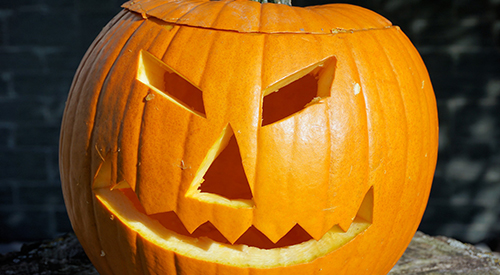Halloween helps us indulge our innate fears: Deakin psychologist
Media releaseHalloween is fast approaching and while many may baulk at the Americanisation of Australian culture, it seems an increasing number can’t get enough of the scary season.
So what is it that makes this spooky holiday so appealing? Why do we love a good fright?
Deakin University Psychologist Dr Richard Moulding said fear was an important part of human nature.
“It’s one of only a handful of fundamental emotional responses we have,” Dr Moulding, a Senior Lecturer in Deakin’s School of Psychology, said.
“Fear is induced by a perceived threat which causes a change in brain and bodily functioning, as well as in behaviour.
“An inborn response for coping with danger, it works by accelerating the breathing and heart rate, increasing muscle tension (which is what causes goose bumps), sweating, alertness and the feeling of butterflies in the stomach.”
While these are all meant to be uncomfortable feelings preparing our body to fight or take flight, Dr Moulding said there were many reasons why modern humans deliberately sought them out.
“It’s not uncommon for people, especially young men, to seek fear as part of a sense of competition, driven by how much individuals can tolerate, with their ultimately feeling a sense of satisfaction when they're able to endure more than their peers,” he said.
“This works in a romantic sense too - a simple way to show someone you care is by protecting them from something scary or dangerous, even if it’s not real.
“For others, a good fright is a way to knock themselves out of a boring routine. There aren’t many everyday threats or dangers present in the modern western world, so stimulating these responses can be fun and exciting.
“Others might just enjoy those physical feelings of an adrenaline rush, racing heart or plummeting stomach, similar to the thrill of a bungy jump or even falling in love. It’s all about pushing yourself outside your comfort zone.
“Indeed, the physiological effects of fear are very similar to excitement in terms of how the body responds to the situation.”
As for the children who will hit the streets to trick or treat on Monday, Dr Moulding said taking part in Halloween under supervision can be safe way for them to confront and explore some of their fears, knowing that it’s all just make believe.
“As they go through their teens, children see scary experiences and films as a rite of passage, they’re excited to be gaining access to something that was deemed taboo or barred to them at a younger age,” he said.
Dr Moulding said that while fears are learned, we are biologically prepared to learn fears of some parts of the world such as snakes and spiders, part of human nature developed as a way of preparing and protecting ourselves from danger.
While Halloween plays on many fears like this – spiders, death, the dark – other popular scary characters like clowns and zombies have be borne from the cultural zeitgeist.
Deakin University Visual Communications Lecturer Joel Zika is currently exploring part of this cultural appropriation of fear in his PhD documenting ghost trains around the world – the Dark Ride Project.
Mr Zika, from Deakin’s School of Communications and Creative Arts, said contemporary “haunts” were are multimillion dollar industry in the US.
“These are hybrid experiences with actors and props, often involving walking through a space, that are run by communities to scare and entertain each other,” he said.
“In the Southern states of Georgia and Alabama people will travel many miles throughout the month of October to visit each other’s haunts, compare technology, acting style and costumes.
“These experiences are genuinely frightening and people actively submit to being threatened and chased through a maze of experiences.”
Like Dr Moulding, Mr Zika can also see the positive connection between fear and other heart pumping activities.
“These modern haunts are the next stage in the evolution of dark rides, which started when ghost trains were introduced to fairgrounds during the Great Depression,” he said.
“Whether they were scary to the rider or not they needed to create the possibility of fear, because of the intimate space they offered to young couples.
“For many youths of the 1930s, 40s and 50s the dark ride was the only place to ensure some private time with another person and any frights were welcomed!”

